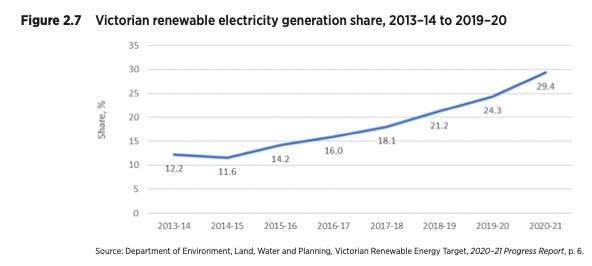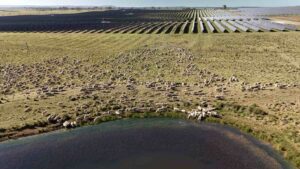The Victorian government being called on to aim higher with its renewable energy targets, after a parliamentary inquiry found the state was well placed to overachieve on its current goals.
A parliamentary inquiry into Victoria’s use of renewable energy published its final report on Thursday, detailing how the state has made strong progress towards its existing 50 per cent renewables target by 2030 – prompting calls for the Andrews government to aim higher.
“While the Victorian Labor government has made important investments in renewable energy, they’re also opening up new areas for gas drilling and letting our coal-fired power plants run well past their expiry date. This is not good enough,” Victorian Greens deputy leader Ellen Sandell said.
“The reality is we need bold action now, with a target of transitioning to 100 per cent renewable energy by 2030.”
The inquiry found that Victoria’s electricity demand may double by 2050, as energy users switch their consumption from gas to electric appliances, and as the adoption of electric vehicles grows, but that the state had sufficient access to high quality wind and solar resources to meet the increased demand with renewables.
Environment Victoria, which told the inquiry that Victoria was on track to exceed its renewable energy targets, says aiming for more renewables could help ‘shield’ consumers from the prospect of higher electricity prices – with the report being published just a day after the Victorian Essential Services Commission announced that Victorian electricity prices are expected to increase by around 5 per cent.
“Transitioning to 100 per cent renewable energy is the only thing that will shield Victorians from both unaffordable energy bills and runaway climate change,” Environment Victoria’s policy and advocacy manager Bronya Lipski said.
“These findings highlight the opportunity before the Victorian government to cut emissions and help Victorians save money on their power bills.”
“This Inquiry makes it clear that Victoria must move quickly and boldly to get to 100 per cent renewable power this decade – ending new fossil fuel production, eliminating emissions from the transport sector and improving our state’s infrastructure away from gas into clean renewable energy.”
The committee found Victoria has sufficient access to the resources needed to transition the state’s electricity system to 100 per cent renewables, and the potential development of an offshore wind industry could reduce the land burden of new infrastructure.
“Pursuing offshore wind projects will relieve pressure on the amount of renewable energy generators and associated transmission infrastructure that will need to be built in renewable energy zones to meet Victoria’s zero emissions target by 2050,” the committee’s report says.
“These projects should be factored into any review of the renewable energy zone infrastructure requirements.”
Victoria has already announced targets for offshore wind, bringing in the first generation from 2028, but with the bulk of the targets focused on 2035 (4GW) and 2040 (9GW).
Victoria currently has a range of short- to medium-term targets for renewable energy uptake, including a 40 per cent renewables target for 2025, and a 50 per cent target for 2030.
The inquiry observed that Victoria had been successful at boosting the share of electricity produced from renewable electricity from around 12 per cent in 2015, to approaching 30 per cent by the 2020-21 financial year, putting the state on track to meet its 2025 renewables target early.

Chief executive of the Clean Energy Council, Kane Thornton told the committee that record levels of investment in renewables was being achieved across small and large scale developments.
“What we have seen over the past five years or so is enormous growth in levels of investment in renewable energy in the state of Victoria,” he said.
“In utility-scale project we have seen record levels of investment in things like wind farms and solar farms throughout the state, but also the growth of households taking the opportunity to put things like rooftop solar on their houses, and now a shift towards household batteries, and that sector really starting to grow.”










